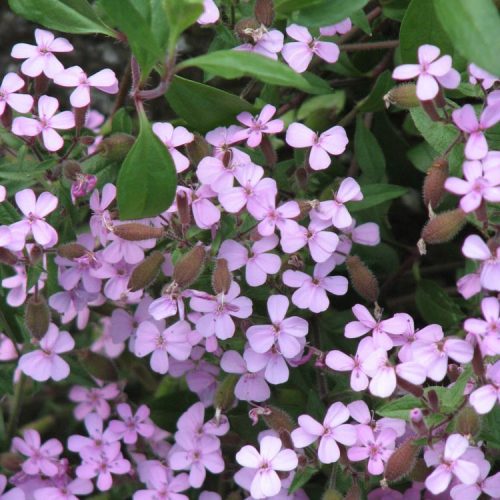Saponaria
Saponaria officinalis (soapwort) has been a familiar and valuable plant in our gardens for hundreds of years. Over the centuries, this pretty perennial acquired numerous local names, such as Bouncing Bet, Hedge Pink, Flop Top, Soap Plant and Fuller’s Herb.
Showing the single result
Showing the single result
Saponaria is a bee-friendly perennial native to the UK and is part of the Caryophyllaceae (Pinks) family. This clump-forming plant has deciduous, ovate foliage and upright stems bearing clusters of sweetly-scented, pale pink, purple or white flowers that provide nectar and pollen for pollinating insects. Depending on the variety, Saponaria may grow to between 0.5–1 metre tall and spread into clumps up to half a metre across, reaching its maximum growth after two to five years.
Cultivation and propagation
Soapwort is easy to grow; it’s low maintenance and requires no pruning. Tolerant of most growing conditions, including chalk, clay and sandy soil, Saponaria prefers a sunny, moist, but well-drained location. Saponaria is generally disease-free. Slugs and snails may sometimes be a problem, so protect young plants.
It’s brilliant as ground cover in cottage gardens, rockeries, wildflower meadows, and wildlife gardens – and our Saponaria plants are 100% pesticide-free, so they’re a fantastic option for organic gardening.
Divide overgrown clumps in early spring to create more plants. Alternatively, sow Saponaria seeds in autumn and overwinter in a cold frame before planting out seedlings in spring.
Uses of Saponaria
Since ancient times, Saponaria Officinalis has been valued as a herbal medicine. Physicians have given it as a tonic, a laxative, and a mild diuretic and also applied it as a treatment for itchy skin.
Thanks to the saponin contained in its roots and leaves, Saponaria is sometimes used as a gentle, natural alternative to detergent for washing wool and delicate fabrics. Soapwort is perfect for washing fleece before spinning, as it retains some of the natural lanolin, so the yarn is more water-repellent. Museum conservators also use soapwort to clean antique tapestries and other fragile textiles, for which modern detergents would be too harsh.
To make your own soap from Saponaria leaves, take a handful of the leaves, crush them and simmer them in water for ten minutes. Cool and strain the liquid, then whisk it into a lovely white froth.
To use Saponaria roots as soap: chop roots into 1cm pieces and simmer in water for 20 minutes, then cool. Blend a little at a time in a liquidiser – this will create a lot of foam! You can also dry the roots thoroughly to store them for later use.

